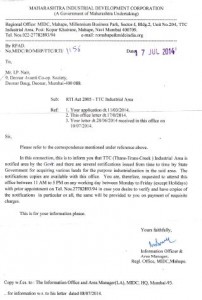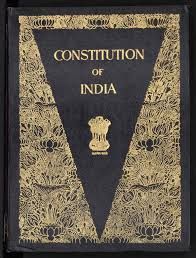Why is MIDC silent?
For Part I see here (http://www.asiaconverge.com/2016/07/extortion-land-grab-navi-mumbais-midc-part-i/)
Legally speaking, MIDC (Maharashtra Industrial Development Corporation) properties are ‘notified’ territories. This means that nobody can use any part of this area for residential real estate development purposes, as it is meant only for industrial units. MIDC is responsible for promoting industrial development in the state.
The same law applies to the territories known as the Trans Thane Creek MIDC (TTC-MIDC). But this rule is being flouted quite brazenly.
The story goes back to 1991, when the Navi Mumbai Municipal Corporation, which was then under the NCP (Nationalist Congress Party) introduced a notification which includes TTC-MIDC within NMMC. Now this was highly odd, even irregular. No civic body can include an MIDC area in its plans unless it has been de-notified first.
Nobody bothered. Many thought it was plain oversight or bad drafting. After all, all SMEs in the TTC-MIDC had taken their land on lease from the MIDC. The Land is owned by MIDC and all units are its lawful lessees. Thus the lease agreements are between the unit holders and the MIDC and not with NMMC. Development charges are paid by unit holders to MIDC and not to NMMC. Strangely, there is nothing to show that the MIDC objected either, as it was legally bound to.
However, all this began changing suddenly. Unit-holders of TTC-MIDC began getting tax notices from NMMC asking them to pay up property taxes. Some units did not see the danger in paying small sums; others consulted their lawyers. Then came the second round of demands – from local politicos inviting entrepreneurs to share their equity with political heavy-weights.
Soon, musclemen from the local corporation began threatening recalcitrant unit-holders with cutting off water and power supply. Some were informed by their banks that NMMC had asked them to freeze their operational accounts. That is when some entrepreneurs began approaching the courts which granted the units a stay from the coercive ways of NMMC. With the courts now in the picture, the NMMC officials have stayed away. But the matter could get explosive because there are constitutional issues at stake.
The NMMC has no jurisdiction
First, as mentioned earlier, all the land in TTC-MIDC – as with any MIDC – is owned by MIDC, not by any municipal corporation. Accordingly, all factory plans are approved by MIDC and not NMMC. Even the Factory Completion Certificate is issued by MIDC and not NMMC. For instance, even the FSI (floor space index enhancement communication received by all the unit holders of TTC-MIDC was from MIDC and not NMMC. See attachment MIDC-EX1.
 All utilities are provided by MIDC – water, electricity and SMEs are billed for these by this very organisation. Other amenities like drainage, fire services, and compliance with infrastructure and environment are still governed by MIDC rules.
All utilities are provided by MIDC – water, electricity and SMEs are billed for these by this very organisation. Other amenities like drainage, fire services, and compliance with infrastructure and environment are still governed by MIDC rules.
All territories notified as MIDCs are awarded the status of “Virtual Development Authority” and “Special Town Planning Authority” within the notified area. As a result, as lawyers will tell you, every law which is made affecting notified state industrial development clusters has to be in accordance with the “Objects & Reasons” published by relevant state government
The only way to extend the hold of any municipal authority over an MIDC is by first de-notifying it. But de-notification isn’t easy. The process for de-notification of any MIDC land is quite clearly laid down in the Industrial Development Act of each state. Section 56 of the MID Act specifies that the state government (ministry of industry) is obliged to publish a notification in its official gazette if it wishes to de-notify (to withdraw any area from) the industrial area. Since no such notification relating to TTC-MIDC has been published to date, it remains a notified area
State Industrial Development Acts are, in turn, backed by the Indian constitution which dwells significantly on the need to promote industry, and insulate it from civilian laws. For instance, Article 243 Q of the Constitution of India provides exemption from constituting a Municipality in Industrial Township/ Notified Area.
 In fact, both the Constitution and the Supreme Court exempt even residential townships from municipal (or political) control if it is classified as an industrial township. These are the laws which have enabled model industrial townships like Jamshedpur to survive repeated attempts by Bihar’s governments to exercise political control and to benefit from revenue generation from such complexes. Thus Jamshedpur could survive even the worst days in Bihar.
In fact, both the Constitution and the Supreme Court exempt even residential townships from municipal (or political) control if it is classified as an industrial township. These are the laws which have enabled model industrial townships like Jamshedpur to survive repeated attempts by Bihar’s governments to exercise political control and to benefit from revenue generation from such complexes. Thus Jamshedpur could survive even the worst days in Bihar.
Clearly, someone in MIDC believes that personal profit is more important than the national objective of industrialisation and the need to encourage employment. Someone believes, that rules and constitutional provisions can be kissed goodbye, if the profit from doing so is greater than the risk involved.
And it appears that such people found a suitable partner in NMMC. For that, do read the next part at http://www.asiaconverge.com/2016/07/extortion-land-grab-navi-mumbais-midc-part-iii/










































COMMENTS